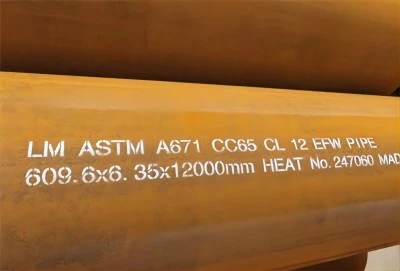ASTM A671 Pipes are crucial components in various industrial applications, particularly in sectors requiring high-performance piping systems for atmospheric and lower temperature services. These pipes are known for their excellent strength, toughness, and reliability, making them ideal for use in oil and gas, petrochemical, and power generation industries. Understanding the manufacturing process of ASTM A671 pipes is essential for engineers, project managers, and industry professionals to ensure they select the right products for their specific needs. This article delves into the intricate process of manufacturing ASTM A671 pipes, exploring each step from material selection to the final heat treatment.
|
|
|
Material Selection:
The manufacturing process of ASTM A671 pipes begins with the careful selection of raw materials. The primary material used in the production of these pipes is carbon steel, specifically chosen for its excellent mechanical properties and suitability for pressure vessel applications. The steel plates used typically conform to standards such as ASTM A516, which is widely recognized for its use in moderate and lower temperature pressure vessels.
ASTM A516 steel is preferred for several reasons:
1. Strength: It offers a good balance of strength and ductility, making it suitable for the demanding conditions often encountered in industrial applications.
2. Weldability: The steel's composition allows for excellent weldability, which is crucial in the pipe manufacturing process.
3. Toughness: It exhibits good notch toughness, especially at lower temperatures, which is a key requirement for ASTM A671 pipes.
4. Formability: The material can be easily formed into the required shapes without compromising its structural integrity.
The selection of the right grade of ASTM A516 steel (Grade 55, 60, 65, or 70) depends on the specific requirements of the ASTM A671 Pipe being manufactured. Factors such as the intended operating temperature, pressure ratings, and specific customer requirements all play a role in determining the exact grade of steel to be used.
Quality control at this stage is paramount. Manufacturers typically conduct thorough inspections and tests on the incoming steel plates to ensure they meet the required chemical composition and mechanical properties. This may include spectrographic analysis to verify the chemical composition and mechanical tests to confirm strength and toughness properties.
Forming:
Once the appropriate steel plates have been selected and verified, the next step in the manufacturing process is forming. This stage involves transforming the flat steel plates into cylindrical shapes that will eventually become the pipes. The forming process is a critical step that requires precision and expertise to ensure the resulting pipes meet the strict dimensional and roundness tolerances specified in the ASTM A671 standard.
The forming process typically involves the following steps:
1. Edge Preparation: The edges of the steel plate are carefully prepared to ensure proper alignment and welding. This may involve trimming, beveling, or other edge treatments depending on the specific welding process to be used.
2. Pre-bending: For thicker plates or larger diameter pipes, a pre-bending operation may be performed to initiate the curvature of the plate. This is often done using a press brake or similar equipment.
3. Rolling: The steel plate is then fed through a series of rollers in a plate rolling machine. These machines typically have three or four rollers that can be adjusted to create the desired curvature. The plate is passed through the rollers multiple times, with gradual adjustments made to increase the curvature until the desired cylindrical shape is achieved.
4. Tack Welding: Once the plate has been rolled into a cylinder, it is often tack welded to maintain its shape before the final welding process.
Throughout the forming process, strict quality control measures are implemented to ensure the pipes meet the required specifications. This includes regular measurements of diameter, roundness, and straightness. Advanced measurement techniques, such as laser scanning, may be employed to verify the dimensional accuracy of the formed pipes.
The skill of the operators plays a crucial role in this stage. Experienced technicians can adjust the rolling process to account for spring-back (the tendency of the metal to partially return to its original shape) and ensure that the final product meets the required tolerances.
Electric Fusion Welding (EFW):
After the steel plates have been formed into cylindrical shapes, the next critical step in manufacturing ASTM A671 Pipes is the welding process. ASTM A671 pipes are distinguished by their use of electric fusion welding (EFW) technology, which creates high-strength welds without the need for filler materials.
Electric fusion welding is a sophisticated process that offers several advantages:
1. High Weld Strength: The process creates welds that are as strong as or stronger than the base metal, ensuring the integrity of the pipe.
2. Consistency: EFW provides a more consistent weld quality compared to manual welding processes.
3. Efficiency: The process is highly efficient, allowing for faster production rates compared to other welding methods.
4. Clean Welds: Since no filler material is used, the welds are clean and free from inclusions that could compromise weld quality.
The EFW process typically involves the following steps:
1. Edge Preparation: The edges of the formed cylinder are carefully prepared to ensure proper fusion. This may involve additional cleaning or machining to create the ideal edge profile.
2. Alignment: The edges of the cylinder are precisely aligned to ensure a perfect match.
3. Welding: An electric current is passed through the edges of the metal, generating intense heat that melts the metal at the joint. The pressure applied during this process forces the molten metal together, creating a fusion bond as it cools.
4. Cooling: The weld is allowed to cool under controlled conditions to ensure proper solidification and to minimize any internal stresses.
Throughout the welding process, various parameters such as current, voltage, and welding speed are carefully controlled to ensure optimal weld quality. Advanced welding equipment often incorporates computer controls to maintain precise control over these parameters.
Quality control during the welding process is rigorous. Non-destructive testing methods such as radiographic testing (RT), ultrasonic testing (UT), or magnetic particle inspection (MPI) are commonly used to verify the integrity of the welds. These tests can detect any defects or inconsistencies in the weld, ensuring that only pipes meeting the highest quality standards are passed on to the next stage of production.
LONGMA GROUP—ASTM A671 Pipe Manufacturer:
When it comes to sourcing high-quality ASTM A671 pipes, LONGMA GROUP stands out as a reputable manufacturer with a strong commitment to excellence. With years of experience in the industry, LONGMA GROUP has established itself as a trusted provider of A671 pipes, known for their superior quality and reliability.
LONGMA GROUP's manufacturing process adheres strictly to industry standards and best practices. Their state-of-the-art facilities are equipped with advanced machinery and technology, enabling them to produce pipes that consistently meet or exceed the requirements of the ASTM A671 standard.
For those in the market for ASTM A671 pipes, LONGMA GROUP offers a compelling combination of product quality, availability, and customer service. Their extensive stock quantity of 50-100 tons ensures that they can meet the demands of various project scales and timelines.
If you are in the process of selecting an ASTM A671 pipe manufacturer for your next project, LONGMA GROUP invites you to reach out and discuss your requirements. Their team of experts is ready to assist you in finding the perfect solution for your specific needs.
To get in touch with LONGMA GROUP and explore their A671 pipe offerings, you can contact them at info@longma-group.com. Their knowledgeable staff will be happy to provide you with detailed information about their products, discuss your project requirements, and offer tailored solutions to meet your needs.














